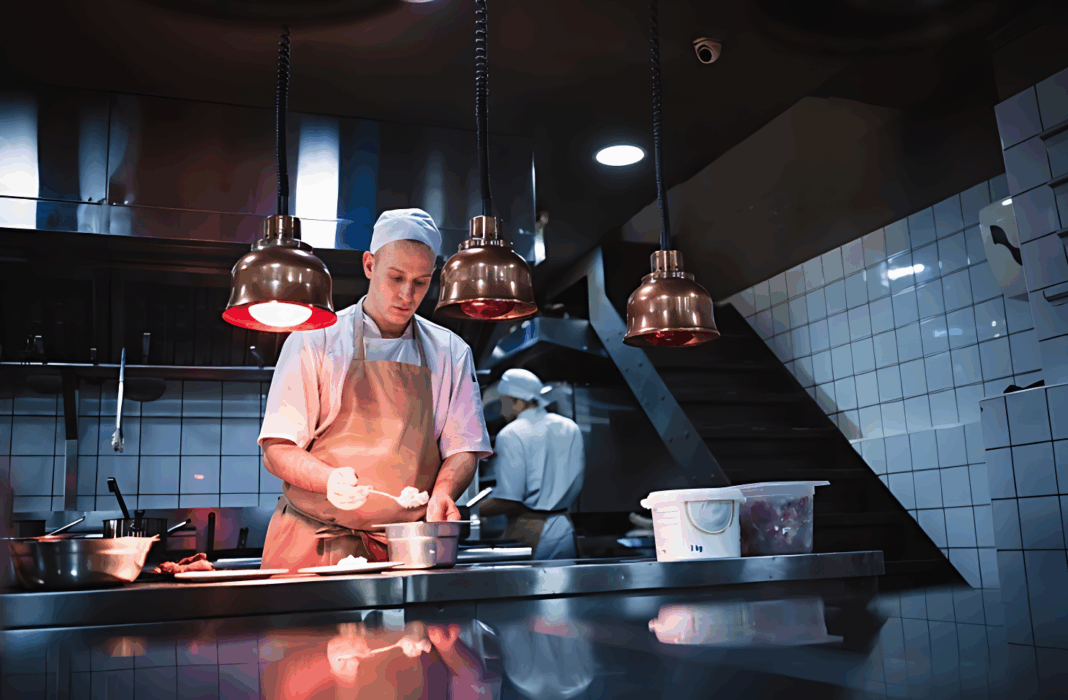Dining at a restaurant is nothing short of an experience. Poor hygiene, however, can ruin it in an instant. From the kitchen to the dining room, every surface, every piece of equipment, and every pair of hands must meet strict cleanliness standards. Failing to do so has consequences that are costly.
This article includes a restaurant hygiene checklist to help managers ensure every aspect of their operation is clean, compliant, and built for long-term success.
Why Restaurant Hygiene Matters
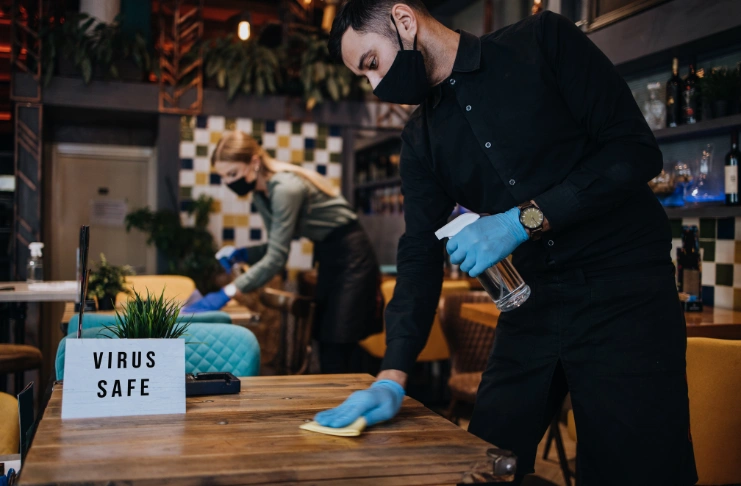
Proper hygiene practices directly impact customer health, business reputation, and regulatory compliance. According to the Centers for Disease Control and Prevention (CDC), foodborne illness affects approximately 48 million Americans annually. Beyond the human cost, hygiene violations can lead to closures, fines, and irreparable damage to a restaurant’s reputation.
Implementing a thorough hygiene system protects both customers and the restaurant business. It creates a safe environment for food preparation while demonstrating professionalism and care to diners.
INDUSTRY INSIGHT
| Recent food safety violations in the U.S. underscore the severe financial and reputational risks restaurants face. In 2023, Kerry Inc. was charged a $19 million fine after salmonella-contaminated cereal sickened 135 people across 36 states. Meanwhile, 2022 inspections in New York City revealed pervasive safety lapses, resulting in fines and public ratings that significantly damaged affected businesses. Consumer behavior reflects these consequences: Studies show 75% of diners avoid restaurants with documented safety violations, making recovery from such cases difficult. Beyond legal penalties, food safety breaches irreparably erode customer trust. For restaurants, rigorous compliance with safety standards and proactive contamination prevention are essential safeguards against financial loss and lasting damage to brand reputation. |
Essential Kitchen Hygiene Practices
Kitchen hygiene forms the cornerstone of restaurant food safety. It includes everything from personal cleanliness to equipment sanitation. Proper kitchen hygiene prevents harmful pathogens from contaminating food and reduces the risk of foodborne illness outbreaks.
Restaurant managers must establish clear protocols that all cooking staff understand and follow consistently throughout their shifts. For example: Implement mandatory hand hygiene protocols requiring staff to wash hands thoroughly for at least 20 seconds with soap and warm water.
- Before handling food
- After using the restrooms
- After touching raw meat, poultry, or seafood
- After handling trash or cleaning chemicals
- After touching face, hair, or clothing
- Between handling different types of food
Staff should also wear clean clothes and appropriate uniforms daily. They should avoid wearing jewelry. They should have hair restraints when handling food.
Preventing Cross Contamination
Cross-contamination occurs when harmful bacteria transfer between foods, surfaces, or equipment. To prevent it:
- Store raw and cooked foods separately, with raw items always below cooked items
- Use separate equipment and utensils for different food types
- Implement color-coded cutting boards (red for raw meat, green for produce, etc.)
- Clean and sanitize all work surfaces between different food preparation tasks
- Store chemicals and cleaning supplies away from food preparation areas
Food Storage Guidelines
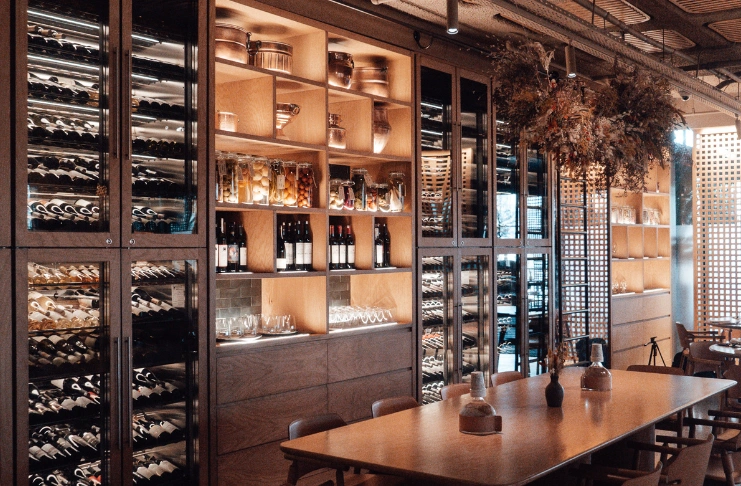
Proper food storage prevents bacterial growth while maintaining food quality and safety throughout the supply chain.
Temperature control represents the most critical factor in safe food storage, as harmful pathogens multiply rapidly when food remains in the temperature danger zone between 40°F and 140°F for extended periods. Restaurant operations must implement strict temperature monitoring protocols to ensure compliance with food safety regulations.
Storage areas also require regular maintenance and organization to prevent pest infestations and maintain food quality. All food products should be stored in appropriate containers with clear labeling systems that include preparation dates and expiration information. The FIFO (First In, First Out) rotation system ensures older products are used before newer arrivals, reducing waste and maintaining freshness.
Refrigerated foods must be maintained at or below 40°F, while frozen items require temperatures of 0°F or below. Dry goods need cool, dry storage between 50-70°F, elevated at least six inches from the floor in airtight containers.
Regular temperature checks and documentation help identify potential problems before they compromise food safety or attract pests to storage areas.
Cleaning Schedule Framework

A comprehensive cleaning schedule ensures no area is overlooked. Your daily cleaning tasks should include:
- Sanitizing all food preparation areas at open, close, and between different food types
- Cleaning cooking equipment, utensils, and small appliances
- Sweeping and mopping kitchen floors
- Wiping down kitchen surfaces, counters, and door handles
- Cleaning and sanitizing refrigerator handles and frequently touched surfaces
- Emptying and cleaning waste bins
- Sanitizing dining tables and chairs between customers
- Cleaning restrooms multiple times throughout the service
Weekly cleaning addresses deeper sanitation needs that daily routines cannot cover. Deep cleaning of refrigeration units, thorough equipment maintenance, and sanitization of areas behind fixed equipment help prevent bacterial buildup and equipment failure.
Monthly cleaning tasks should include ceiling vents, air filters, and storage area organization that maintains long-term cleanliness standards.
Successful cleaning schedules require clear documentation and regular monitoring to ensure compliance. Staff training on proper cleaning procedures and chemical safety protects both employees and food quality while meeting regulatory requirements for sanitation and health inspections.
Safe Food Preparation Protocols
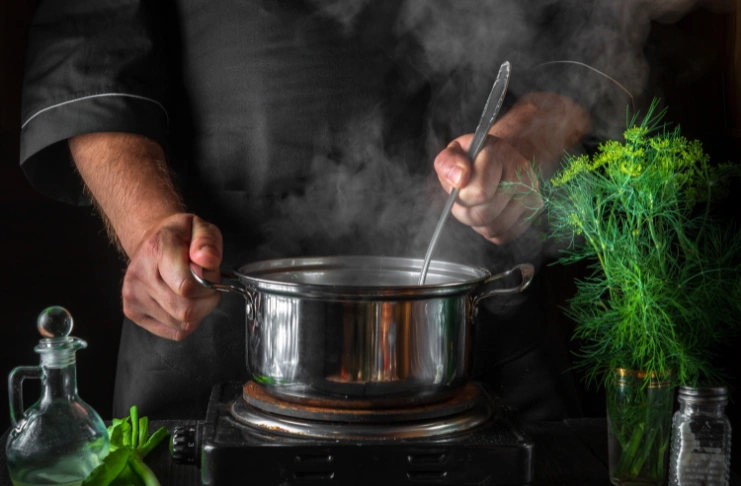
Food preparation safety takes into account cooking techniques, temperature control, and timing protocols that prevent foodborne illness while maintaining food quality.
Cooking food to proper internal temperatures kills harmful pathogens that could cause serious health problems for customers. Poultry requires cooking to 165°F, ground meats to 160°F, and whole cuts of beef, pork, and lamb to 145°F with a three-minute rest period.
Proper thawing techniques prevent bacterial growth during food preparation. Safe thawing methods include refrigeration, cold running water, or microwave defrosting, while countertop thawing creates dangerous temperature conditions.
Cooked foods require rapid cooling from 135°F to 70°F within two hours, then to 41°F within four additional hours to prevent bacterial multiplication.
Reheating previously cooked foods demands temperatures of at least 165°F throughout the entire product. Time limits for food in the danger zone help prevent contamination, with prepared foods requiring refrigeration or service within two hours of preparation to maintain safety standards.
Waste Management Best Practices
Proper waste handling prevents pest infestations and contamination. You should:
- Empty trash containers regularly throughout the day
- Use leak-proof, durable trash bags
- Keep waste containers covered and away from food preparation areas
- Clean and sanitize trash receptacles daily
- Separate food scraps for composting when possible
- Store waste in designated areas away from food storage
- Implement grease trap maintenance protocols
- Train staff on the proper handling of different waste types
Pest Control Strategies
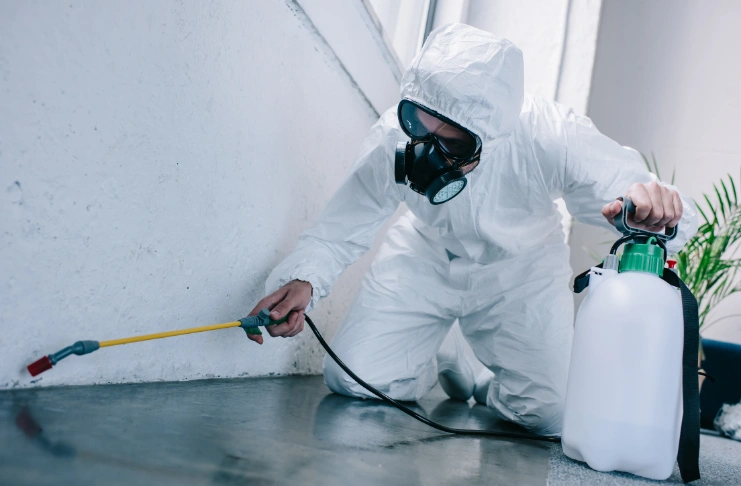
Effective pest control requires proactive prevention rather than reactive treatment after infestations occur.
Sealing entry points around doors, windows, and utility connections prevents pest access while maintaining climate control efficiency. Regular inspections identify potential problems before they become serious infestations that could force a restaurant closure or damage its reputation.
Professional pest control services provide expertise and treatments that complement internal prevention efforts. Quarterly inspections and treatments address seasonal pest patterns while maintaining compliance with local health regulations. Documentation of all pest control measures creates records that demonstrate due diligence during health inspections.
Prevention strategies focus on eliminating attractive conditions for pests. Proper food storage in sealed containers, elimination of standing water, and regular cleaning of areas where food debris might accumulate reduce pest attraction.
Staff training helps employees recognize early signs of pest activity and respond appropriately to prevent minor issues from becoming major problems.
Dining Area Hygiene
The dining room creates customers’ first impression of restaurant cleanliness and directly influences their perception of food safety standards. That’s why:
- Clean and sanitize tables and chairs between each customer
- Regularly clean condiment containers and menus
- Sanitize high-touch areas like door handles and POS systems frequently
- Vacuum or sweep floors during service lulls
- Maintain clean restrooms with regular checks throughout service
- Train front-of-house staff on proper hygiene practices
- Keep cleaning activities discreet to maintain the dining ambiance
Staff Training Requirements

Proper staff training ensures all employees understand food hygiene requirements and implement them consistently throughout their work.
Food safety certification for managers and key staff provides expertise for training other team members while ensuring compliance with specific regulations that vary by location. Regular training sessions help introduce new staff to established protocols.
Hand washing training deserves special attention due to its critical importance in preventing foodborne illness. Proper technique, timing, and frequency must be demonstrated and practiced until they become automatic behavior.
Cross-contamination prevention requires an understanding of how bacteria spread and the specific steps needed to prevent transfer between different food items and surfaces.
Documentation of training activities creates records that demonstrate compliance efforts during inspections while helping identify areas where additional training might be beneficial. Regular assessment and feedback help maintain high standards and provide opportunities for continuous improvement in food safety practices.
Restaurant Hygiene Checklist for Managers
Use this audit checklist monthly to ensure compliance with safety protocols at your restaurant:
- All staff demonstrate proper hand-washing technique
- Temperature logs are complete and within safe ranges
- Food storage areas are clean and properly organized
- The cleaning schedule is being followed and documented
- No evidence of pest activity is present
- All equipment is clean and in good working order
- Waste disposal areas are clean and properly maintained
- Chemical storage follows safety guidelines
- Staff are following personal hygiene requirements
- Cross-contamination prevention measures are in place
- Emergency safety equipment is accessible and functional
- Restrooms are clean and properly stocked
If your restaurant checks all these boxes, congratulations. You’re on the right track.
Conclusion
Great food is only great if it’s safe to eat. That’s why maintaining hygiene is the foundation of a successful restaurant business. If your restaurant isn’t ticking off the restaurant hygiene checklist, it’s time to revisit your protocols and raise the standard.
Frequently Asked Questions
1. What needs to be cleaned in a restaurant?
Everything that comes into direct contact with food or customers requires cleaning and sanitizing, including work surfaces, equipment, utensils, dining areas, restrooms, storage areas, floors, walls, ceilings, and high-touch points like door handles and light switches.
2. What is good personal hygiene in restaurants?
Good personal hygiene in restaurants includes frequent and proper hand washing, wearing clean uniforms, using hair restraints, avoiding jewelry, covering wounds properly, reporting illness, maintaining clean fingernails, and refraining from eating, drinking, or smoking in food preparation areas.
3. What is hygiene in a restaurant?
Restaurant hygiene encompasses all practices that prevent contamination and ensure food safety, including personal cleanliness, proper food handling, sanitation of facilities and equipment, pest control, waste management, and maintaining appropriate food storage temperatures to prevent foodborne illness.
4. What does not need to be sanitized in a restaurant?
Items that don’t come into direct contact with food or mouths typically don’t require sanitizing, such as floors (though they need cleaning), decorative items, office areas, and unopened packaged foods. However, all food-contact surfaces must be both cleaned and sanitized.
5. What are the basic guidelines for cleanliness?
Basic cleanliness guidelines include separating raw and cooked foods, maintaining proper temperature control, regular hand washing, cleaning and sanitizing all food-contact surfaces, proper waste disposal, preventing cross-contamination, and implementing a comprehensive cleaning schedule.
6. How often should a restaurant be cleaned?
Restaurants require different cleaning frequencies: food preparation surfaces should be sanitized before use and between different food types; dining areas need cleaning between customers; bathrooms require multiple daily cleanings; while deep cleaning of equipment, storage areas, and ventilation systems should occur weekly or monthly.
7. What is the most common health violation in restaurants?
The most common health violations in restaurants are improper hand washing among employees, cross-contamination between raw and ready-to-eat foods, and incorrect holding temperatures for potentially hazardous foods.
8. What are the food service hygiene standards?
Food service hygiene standards include maintaining clean facilities, proper personal hygiene among staff, safe food preparation techniques, temperature control during storage and cooking, preventing cross-contamination, proper waste management, documented cleaning procedures, and regular staff training.
9. What are 5 ways to maintain good hygiene?
Five essential ways to maintain good hygiene in restaurants include implementing rigorous hand-washing protocols, preventing cross-contamination between food types, maintaining proper food temperature controls, establishing comprehensive cleaning schedules, and ensuring proper waste management.
10. What are the 10 principles of safe food handling and hygiene?
The 10 principles include: proper personal hygiene, preventing cross-contamination, cooking food to safe temperatures, rapid cooling of hot foods, safe reheating practices, appropriate food storage, clean and sanitized equipment, pest control, chemical safety, and comprehensive staff training.
11. What are 5 personal hygiene rules in the kitchen?
Five critical personal hygiene rules include thorough hand washing before handling food and after any contamination risk, wearing clean, appropriate clothing and hair restraints, avoiding working with food when ill, covering cuts with waterproof bandages and gloves, and refraining from eating, smoking, or touching the face while handling food.
12. What are the 5 essential food safety and hygiene practices?
The five essential practices are: maintaining proper personal hygiene (especially hand washing), preventing cross-contamination between raw and cooked foods, cooking to correct temperatures to kill harmful pathogens, refrigerating foods promptly and at proper temperatures, and cleaning and sanitizing all food-contact surfaces regularly.


